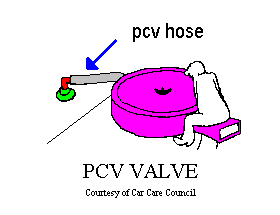Checking Your PCV Valve
*MEDIUM*
You should check your PCV valve and related hoses at every oil change. The PCV valve can be inspected with engine OFF or ON. Follow this procedure:
- Park the vehicle on level ground in a well-ventilated area with the engine OFF, the parking brake engaged, and the transmission in PARK (for automatic) or REVERSE (for manual). Raise the hood.
- First check the condition of the PCV hose and connections. The PCV system must be airtight to work properly. Feel the PCV hose; it is connected between the valve cover and the carburetor or throttle body. A second hose may be connected between the other valve cover and the crankcase filter if the filter is located inside the air cleaner. A hard or cracked hose should be replaced. Make sure there are no loose connections in the vacuum hoses.
- Remove the PCV valve from the vacuum hose connecting it to the carburetor
or throttle body.
Shake it gently. If a light clicking noise is heard, the valve is OK. Install it back into the hose and reconnect the hose to the engine. However, if there is no clicking noise, the valve is clogged and must be replaced with a new one. The PCV valve is prone to clogging because it regulates the flow of burned and unburned gases, both of which contain sticky varnish and resins. - To further check the PCV valve, start the engine and pinch the PCV rubber hose hard enough to stop all air flow. The engine idle speed should decrease about 10% when the hose is pinched if the PCV valve is functioning properly.
- Alternatively, the hose can be removed from the idling engine. A hissing sound should be heard at the PCV valve opening. If a strong vacuum can be felt at the exposed end, the valve is operating normally. If a vacuum is not felt, the hose or valve is clogged.
- Turn OFF the engine if a vacuum was not felt. Remove the hose and inspect the inside. If it is dirty, clean the hose in mineral spirits or replace it with new one. Do not soak the hose in a solvent; it will swell and become deformed. Be sure to firmly reconnect the valve to its grommet or hose. If the hose was clean upon inspection, the PCV valve is clogged and must be replaced.
- Confirm the operation of the entire PCV system last by starting the engine again. Remove the crankcase breather filter and hold a small piece of cardboard over the opening. After about one minute, suction should hold the cardboard in place. If it does not, the vacuum is too weak and the PCV valve must be replaced, if not already done for previous reasons. If the vacuum at the crankcase filter opening is still weak after a new PCV valve is installed, clean the PCV hose, check for loose connections, or clean the engine port to which it is connected. Close the hood.
